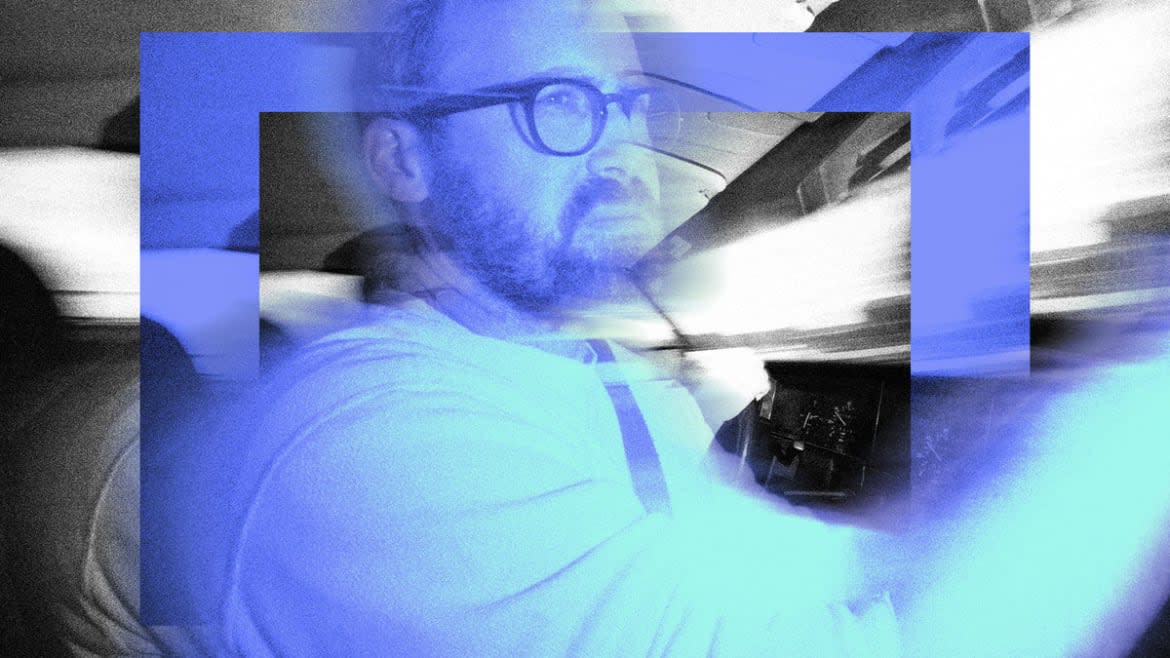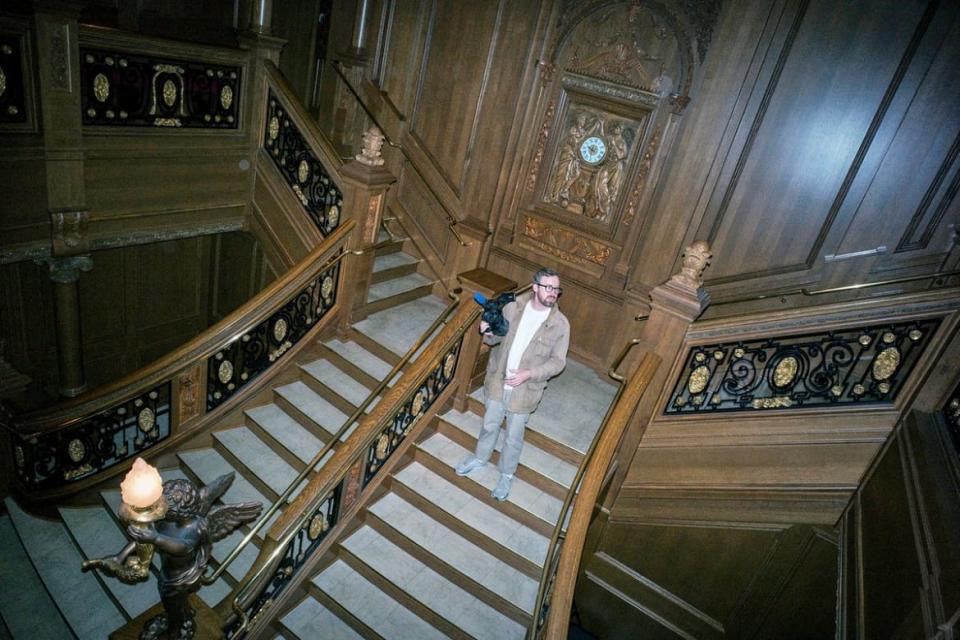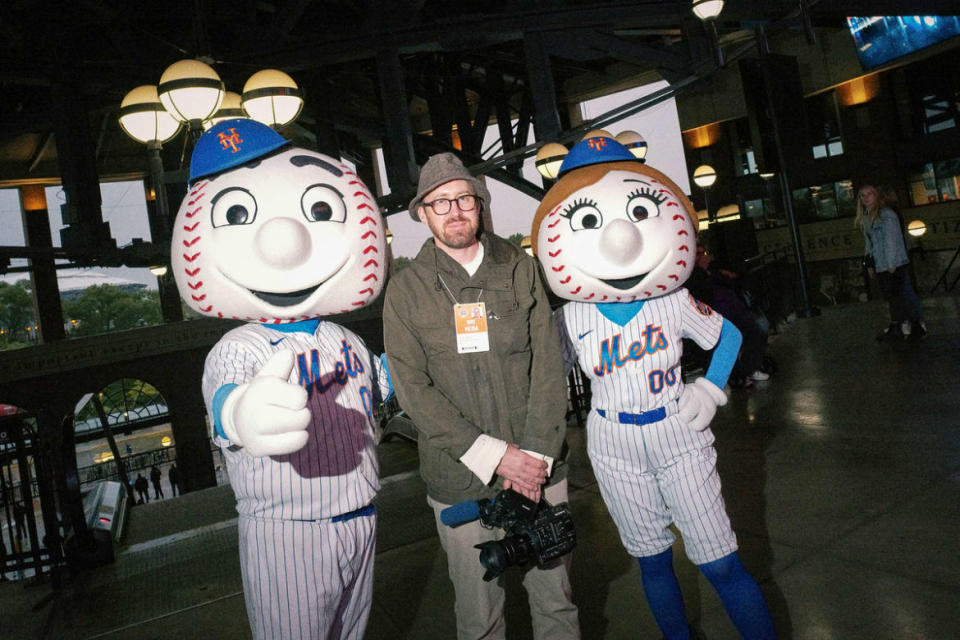John Wilson Reveals Who Blew Up That Car on ‘How To With John Wilson’

- Oops!Something went wrong.Please try again later.
Before I even pose my first question to John Wilson, the eccentric creator of HBO’s most bizarre series How To with John Wilson, he starts asking me questions. Wilson is always the one behind the camera, looking for answers from his—well, let’s just call them unique subjects. So, when our interview begins, as always, he’s the interrogator.
“There’s some heavy stuff in there,” Wilson says of Season 3. “So, uh, what are you curious about?”
Everything. I tell him I want to know everything, because How To has busted my brain more than any other series I’ve watched in the past year. (That distinction previously belonged to Nathan Fielder’s The Rehearsal; not so coincidentally, Fielder serves as an executive producer on How To.) Since 2019, Wilson has documented his strange journeys through New York, loosely explaining how to accomplish simple tasks like preparing risotto, tasting wine, or going to sports games. Instead of actually showing viewers how to complete these quests, though, Wilson loses himself in odd subcultures of the city, like vacuum conventions and Avatar fanclubs, and in doing so, somehow always reveals an enlightening aspect of human nature.
Unfortunately, in our quick Zoom interview, Wilson and I don’t have time to untangle all of his knotted webs—unpacking a single episode of How To alone would probably take a week. So I settle on wanting to know more about how he chose to end the show, as the series finale will air next Friday. This season has been darker than the previous two, which is somewhat shocking, considering they largely centered on the harrowing effect the pandemic had on New York City.

Also piquing my interest is this week’s episode, which sets out to teach viewers about bird watching. Instead, Wilson meets with a boatload of Titanic conspiracy theorists, who believe the Titanic never sank. Instead, they argue, it is a decoy ship called Olympic that lives at the bottom of the ocean. Wilson also uses the episode to confess to using fake shots in his “documentary” show, and ends the second-to-last chapter on a (literal) bang.
Below, Wilson offers a slight peek behind the scenes of his creative genius, his collaborations with big names like Fielder and Steven Soderbergh, and whether or not someone actually blew up his car. (A mysterious stalker, Wilson makes us believe, has been spending the whole episode trying to hunt down the filmmaker and shut down his Titanic conspiracy exploration—although Wilson makes it out unscathed, his car does not.)
(Warning: Spoilers ahead for the most recent episode of How To with John Wilson, “How To Watch Birds.”)
New York is a very specific, special place. You travel outside of the city in the series, but could this show ever be set in another city?
I chose New York as a homebase because I grew up in and around here. I can be critical of it because I have this personal relationship. I also have a complicated relationship with New York, which makes it really rich material. But there’s so much on the street here that I don’t see [elsewhere], especially in a place like LA.
At the same time, I wanted to make this work because I wasn’t seeing New York depicted the way that I saw [it] and the way that, I feel, it really is. I feel that way when I go to other cities too. Even with Los Angeles, I was just there—I don’t understand why it’s one of the most overshot cities in the country and I haven’t seen it depicted the way it actually is. There’s a lot of potential in different cities for this kind of perspective. I haven’t gotten there conceptually, yet.
‘How To With John Wilson’ Is Still TV’s Most Profound and Bizarre Miracle
Your show is ending after three seasons, which all have felt different in their own ways. One takes place in pre-pandemic New York, the next in the middle of the pandemic, and this final saga in a somewhat post-pandemic society. What would you say are the themes of each season?
The first season was a bit more naive and optimistic about certain things. The second season had a bit more to do with exiting the cocoon we were all in. This third season is a little darker personally, dealing with the long tail of a lot of the stuff that we didn’t quite process immediately after the pandemic.
If How To took place in any other era of New York, past or future, where would you go?
The future, wow. I try not to lean too hard into nostalgia or anything. My favorite time to shoot New York is right now. People don’t embrace the day-to-day stuff as much. So many people get trapped in these nostalgic loops and try to do so much forecasting, or reminiscing. There are so many traces of the ’70s and ’80s, all these romantic eras of the city, in a way. I really like capturing the parts of it that still exist from those time periods. The past, the present, and the future are all here.
How do you see current-day New York?
Hot. Humid. All the air quality alerts stuff, the flooding here, it is entering this new phase that a lot of people aren’t prepared for. That is affecting people in a strange way. People are still just going to work and trying to enjoy themselves. It hasn’t changed in that way.

You mentioned that this season is darker than the others. It also feels a lot more personal. Was that a goal of yours, heading into the last episodes?
Each season is personal in its own way, but conceiving this as the last season, I was really excited to throw a lot at the wall that I was nervous to or didn’t feel comfortable doing in the first couple seasons. It’s a lot more ambitious, production wise and thematically. We deal with some very big, existential issues that I didn’t quite want to confront in earlier episodes. I had some stuff I wanted to get off my chest, whether it was production secrets about the show or [something else]. There’s some stuff in this season that people in my life are going to be hearing for the first time as it airs. I have yet to see how that will be received.
Seeing as this is the end, do you think you got everything off your chest?
No. There’s always more to say. But in terms of the scope of this project, there are certain themes that run throughout the series that reach this point by the finale that feels conclusive.
So, I have to ask about the end of Episode 5.
The one about birds?
Yes. You tease that someone is chasing after you throughout the entire episode, and then suggest that they blew up your car. Let’s unpack that. Did it actually spontaneously combust, or was that something of your own doing?
The production of that episode is its own huge story. I wanted the second half of that episode to shift dramatically into a Steven Soderbergh type of thriller. He was also a consultant. We talked with him about it. He gave us some advice on how to blow up a car. The car itself, it mirrors the Titanic duplicate. In real life, I blew up a duplicate of my own car in order to commit some kind of fraud.
It’s in line with that whole Titanic conspiracy. I basically wanted to make an episode that gave anyone permission to fabricate something within a documentary. This idea of purity in nonfiction, it’s silly to me. I wanted to make a piece of work to point to and be like, “No, it’s OK. We’re all making stuff up as we edit, as we shoot, as we write.”
‘How To With John Wilson’ Goes to the World’s Most Emotional Vacuum Convention
You’ve added Soderbergh to your lengthy list of collaborators, which also includes Nathan Fielder. What’s the best advice Fielder has given you as an executive producer on your show?
During the first season, we collaborated very intensely. He was there every day over my shoulder. He’s very good with narrative, and figuring out a way to turn all of this random material into an actual story. One of his biggest things is: Do not repeat yourself. If I did something once in one episode, he never wanted to see it again in another episode. Whether it’s imagery, a theme, anything like that, that’s something he really drilled into me and I’ve stuck with. Keep people on their toes. Keep people surprised about what they’re about to see. People get tired once they can see a formula or recognize a formula or see repeat imagery.
I also collaborate a lot with Michael Koman, who is one of Fielder’s collaborators from Nathan For You. All of us together, we have a value system that we put on each episode to make sure it feels funny but personal, and also surprising.
Did HBO push back at all on that clip where they shut you out of their Emmys afterparty? Or have they at least promised to invite you to the next one?
They didn’t say anything to me about that. I honestly delivered the episode, they had a few notes about other stuff, but didn’t say anything about that. I did eventually get into the party. HBO has been great. The fact that they’re okay with light roasting like that says a lot. They knew that when they greenlit this show, they may eventually become part of the story.
Keep obsessing! Sign up for the Daily Beast’s Obsessed newsletter and follow us on Facebook, Twitter, Instagram and TikTok.
Get the Daily Beast's biggest scoops and scandals delivered right to your inbox. Sign up now.
Stay informed and gain unlimited access to the Daily Beast's unmatched reporting. Subscribe now.

